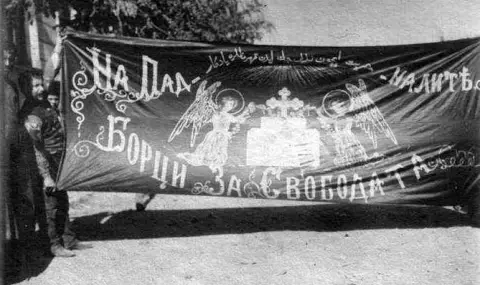Macedonia occupies a key place not only in the history of Bulgaria, but also of the Ottoman Empire and modern Turkey.< /strong>
In 1908, events started from Macedonia that would change the fate of the Balkan Peninsula.
On July 3, 1908, Major Ahmed Niyazi Bey and Enver Bey raised a revolt among the servicemen of the Third Army stationed in the Macedonian city of Resen. Military units commanded by Niyazi Bey and Eyup Sabri entered Bitola and captured the local military commander Osman Pasha.
A group of about 200 soldiers and civilians set out for the capital with demands for the restoration of the constitution of 1876. The uprising quickly spread among the military divisions of the entire European territory of the empire and the government in Constantinople failed to organize an armed resistance.
On July 24, 1908, Abdul Hamid II capitulated and officially announced his agreement to satisfy the demands of the rebels.
Thus begins the revolution of the Young Turks.
Young Turks is a general name used to designate several groups of dissidents and conspirators that arose at the end of the 19th century, both on the territory of the empire and in emigration. In 1889, at the higher military medical school in Constantinople, Abdullah Jevdet and his fellow students founded the Committee for Unity and Progress as an illegal political organization, which quickly included students from other higher educational institutions in the capital. Subsequently, the Committee became the dominant force of the Young Turk movement. When the organization was exposed by the authorities, some of the leaders fled abroad and joined the Ottoman dissident emigration in Paris, Geneva and Cairo.
The Bulgarian government of Alexander Malinov took advantage of the instability that occurred in the Ottoman Empire immediately after the Young Turks came to power, and on September 22, 1908, in the church of “St. Forty Martyrs“ in Tarnovo, with a special manifesto, proclaimed the independence of Bulgaria, with Prince Ferdinand I accepting the title of Tsar of the Bulgarians.
Almost at the same time, Austria-Hungary announced that it was annexing Bosnia and Herzegovina, which had been under its occupation for 30 years under the Treaty of Berlin.
A few years later, an assassination attempt in Sarajevo marked the beginning of the First World War.
VMORO and the Young Turks
A central element of the Young Turks revolution is the cooperation between the Young Turks and the members of the VMORO. Due to the chaos created in the central leadership after the uprising of 1903 and the death of Damyan Gruev in 1906, the internal organization does not seem to have a clear position regarding the Young Turks and their activities, and a number of memoir materials from this period speak of a lack of coordination, and in general surrender of information between the various revolutionary districts immediately before and after the declaration of the Hurriyat. Nevertheless, letters were exchanged between the Young Turks and the most influential Bitola Revolutionary District, thanks to which the visible tension caused by the unsettled relations between the two organizations was reduced.
The initial euphoria and the proclaimed new equality between the ethnic groups in the empire made the Bulgarian troops stop the armed struggle and come down from the mountains with the favor of the Ottoman authorities. VMORO emerges from illegality and its main wings are divided into two new political parties - the Union of Bulgarian Constitutional Clubs and the People's Federal Party (Bulgarian section). In 1908, four Bulgarian deputies were elected to the Turkish parliament: Todor Pavlov, Pancho Dorev, Dimitar Vlahov and Hristo Dalchev.
Some voivodes such as Alekso Stefanov and Todor Alexandrov completely distrust the promises of the Young Turks.
Others like the legendary Apostle Petkov – The Enijevardar sun met their death in the struggle against the Young Turks precisely after the renewal of revolutionary activity.
Jane Sandanski benefits from the change of power in the Ottoman Empire.
Not long after, the nationalism of the Young Turks prevailed over the reformist ideals, and they resumed repression with renewed vigor.
On April 13, 1909, the army units of the Istanbul garrison revolted and demanded the return of Sharia (customary law), the Islamic order and the expulsion of the leaders of the Young Turks from the Ottoman Empire, recalls the website "Bulgarian History".
p>The Sultan immediately accepted their demands. The leaders of the Young Turks, at the head of the army corps in Thessaloniki and Edirne, as well as the created paramilitary formations, set out on a march towards Istanbul. Under the leadership of Yane Sandanski, Hristo Chernopeev and Todor Panitsa, 1,200 Chetniks from the Internal Macedonian-Odrina Revolutionary Organization (VMORO) participated in it. As they approached the city, the units of the Ottoman Navy also sided with the counter-revolutionaries, blocking the capital by water. On April 26, they managed to put the capital completely under their control, and the Sultan's counter-coup attempt was finally foiled. The next day, the Ottoman Empire dawned with a new sultan – Mehmed V.
